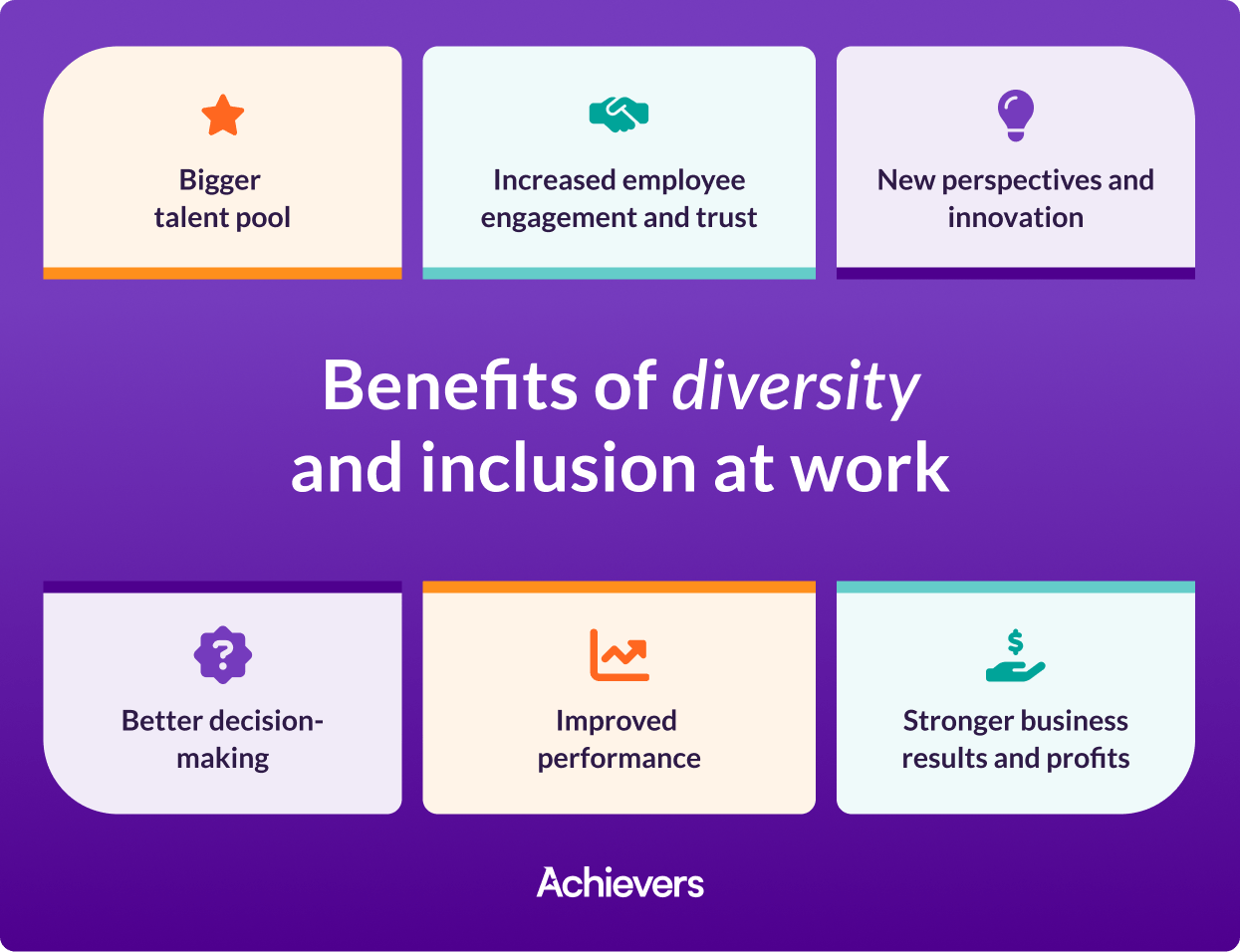Workplace Diversity and Inclusion: Building a Stronger, More Inclusive Workforce
In today’s fast-paced and globalized business environment, workplace diversity and inclusion have become more than just buzzwords—they are essential components of a successful and sustainable organization. Companies that embrace diversity and foster inclusive cultures are not only better positioned to attract and retain top talent, but they also experience improved innovation, employee satisfaction, and performance.
In this article, we will explore the importance of diversity and inclusion (D&I) in the workplace, how it benefits organizations, and how companies can effectively promote a culture of diversity and inclusion.

Diversity and inclusion in the workplace lead to stronger teams and enhanced business outcomes.
What is Workplace Diversity and Inclusion?
Diversity refers to the presence of differences within a given setting. In the workplace, it typically includes various dimensions such as:
- Race and ethnicity
- Gender and gender identity
- Age
- Cultural background
- Disabilities
- Sexual orientation
- Religious beliefs
- Socioeconomic status
On the other hand, Inclusion is about creating an environment where all individuals feel valued, respected, and supported. Inclusion means fostering a culture where every employee, regardless of their background, has an equal opportunity to contribute, grow, and succeed within the organization.
The Intersection of Diversity and Inclusion
While diversity focuses on the representation of various groups in the workforce, inclusion ensures that those diverse individuals feel welcomed, accepted, and able to thrive. Both are integral to creating a workplace culture that is not only equitable but also innovative and forward-thinking.
Why is Diversity and Inclusion Important?
1. Attracting and Retaining Talent
A diverse and inclusive workplace can help companies attract a broader pool of candidates, particularly those from underrepresented groups. Job seekers today are increasingly prioritizing inclusivity when choosing employers. According to a study by Glassdoor, 67% of job seekers consider diversity an important factor when evaluating job offers and companies.
When employees feel included and supported, they are more likely to stay with the organization long-term, reducing turnover and fostering employee loyalty.
2. Enhancing Innovation and Creativity
Diverse teams bring varied perspectives, experiences, and problem-solving approaches. This diversity of thought can fuel innovation and creative solutions to complex problems. According to a McKinsey report, companies in the top quartile for racial and ethnic diversity are 35% more likely to have financial returns above their respective national industry medians.
When employees feel their unique ideas are valued, they are more likely to contribute creatively, leading to breakthrough innovations and a competitive edge in the marketplace.
3. Improving Employee Engagement and Productivity
Inclusive workplaces foster a sense of belonging, which leads to higher levels of employee engagement. Engaged employees are more committed to their roles, show greater productivity, and are more likely to take on leadership roles within the company. A study by Gallup found that highly engaged teams show 21% higher profitability than those that are less engaged.
4. Better Decision-Making and Problem-Solving
Diversity of thought enhances decision-making processes. When teams are diverse, they bring a range of viewpoints, allowing for better discussion, evaluation of alternatives, and more effective decision-making. This diversity leads to more thoughtful, well-rounded decisions, which ultimately improve the performance of the company.

Diversity and inclusion enhance workplace collaboration and creativity.
How to Promote Diversity and Inclusion in the Workplace
Creating a diverse and inclusive culture requires intentional action, not just a statement of values. Below are several strategies organizations can implement to promote diversity and inclusion in their workplaces:
1. Commit to Leadership Accountability
For diversity and inclusion to become embedded within the organizational culture, leadership must actively champion and hold themselves accountable for D&I goals. When executives prioritize diversity, it sets a tone that cascades through all levels of the organization.
Leaders can demonstrate their commitment by:
- Setting clear diversity goals
- Regularly reviewing and updating D&I policies
- Investing in D&I training and development
- Ensuring a diverse leadership pipeline
2. Offer Training on Unconscious Bias
Unconscious bias can influence hiring decisions, promotions, and day-to-day interactions in ways that may unknowingly undermine inclusion. Offering regular training on unconscious bias helps employees recognize and address these biases, leading to a more equitable and fair workplace.
Training programs should focus on:
- Identifying common types of unconscious biases
- Understanding how bias affects decision-making
- Implementing strategies to reduce bias in hiring and team dynamics
3. Implement Inclusive Hiring Practices
Inclusive hiring is crucial for building a diverse workforce. Companies should ensure that their hiring practices are unbiased and that they actively seek to attract candidates from diverse backgrounds.
Steps include:
- Expanding the recruitment process to reach diverse candidate pools
- Using inclusive language in job descriptions
- Standardizing interview processes to ensure fairness
4. Create Employee Resource Groups (ERGs)
Employee Resource Groups (ERGs) are voluntary, employee-led groups that foster a sense of community and belonging among employees who share common interests, identities, or experiences. ERGs provide a platform for underrepresented groups to voice their concerns, support each other, and influence organizational policies.
5. Ensure Equal Opportunities for Advancement
To truly foster inclusion, it’s important that all employees, regardless of their background, have access to career development opportunities. Companies should ensure that:
- There is equal access to mentorship and sponsorship programs
- Promotions are based on merit and not influenced by biases
- Training and development opportunities are available to all employees
6. Promote Flexibility and Work-Life Balance
Diversity and inclusion are not just about demographics—they’re also about how a company supports its employees’ well-being. Offering flexible work hours, remote work options, and support for work-life balance ensures that all employees can succeed, regardless of their personal circumstances.
The Benefits of a Diverse and Inclusive Workforce
1. Boosts Company Reputation
Companies with strong diversity and inclusion practices are often seen as more attractive employers. A reputation for being inclusive can help you stand out in a competitive job market, helping you attract top talent from diverse backgrounds.
2. Increases Market Competitiveness
A diverse workforce is better equipped to understand and serve a diverse customer base. Companies with employees from different backgrounds can more effectively meet the needs of a global market, driving innovation and expanding their reach.
3. Strengthens Team Collaboration
Inclusive teams that value diversity are more likely to foster a culture of trust and respect, leading to better collaboration. When employees feel that their ideas and contributions are valued, they are more likely to work together toward common goals.
FAQs About Workplace Diversity and Inclusion
Q1: Why is workplace diversity and inclusion important?
Workplace diversity and inclusion promote better decision-making, innovation, employee engagement, and productivity. It also helps attract top talent and fosters a positive company culture.
Q2: How can a company improve its diversity and inclusion efforts?
Companies can improve their D&I efforts by setting clear goals, offering unconscious bias training, implementing inclusive hiring practices, and promoting flexible work arrangements.
Q3: What are the benefits of a diverse workforce?
A diverse workforce can enhance creativity, innovation, problem-solving, and decision-making. It also improves employee engagement, reduces turnover, and strengthens the company’s reputation.
Q4: How does diversity impact business performance?
Studies show that companies with diverse teams outperform their competitors in areas like profitability, creativity, and innovation. Diverse teams bring a variety of perspectives, which leads to more effective solutions and better business outcomes.
Conclusion
Diversity and inclusion are not just trends—they are integral to the long-term success of any organization. Embracing a diverse workforce and fostering an inclusive culture leads to increased innovation, employee engagement, and business success. By taking concrete actions to prioritize diversity and inclusion, companies can build stronger teams, enhance their reputation, and contribute to a more equitable society.

Inclusive work environments foster a sense of belonging and innovation.
Related Articles:
– The Role of Leadership in Diversity and Inclusion
– How to Build an Inclusive Company Culture
